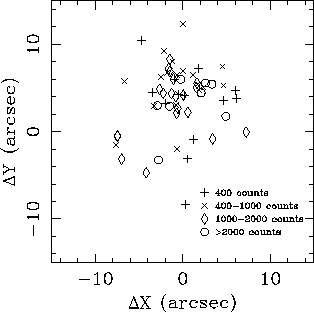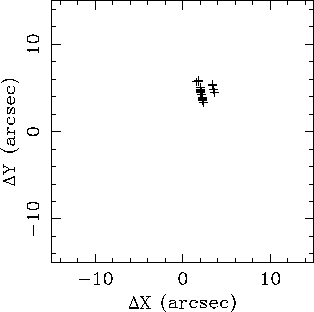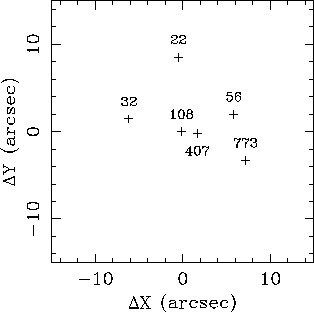| About ROSAT |
ROSAT Home Page | ROSAT Images |
|---|
[Kürster and
Hasinger1992a, Kürster and
Hasinger1993b]
The above MPE ROSAT AMCS status reports, give details of the deviations seen between XRT derived positions and those given in catalogues (e.g., SIMBAD, the Bright Star Catalogue, an internal MPE X-ray catalogue, and PI supplied positions).
Previously, systematic discrepancies have been noted between the optical
and X-ray positions of ROSAT targets.
In an MPE study, the ![]() scatter of the distribution of optical
versus X-ray positions was 6.1'' for the PSPC-B and 6.4''
for the HRI.
The PSPC data showed a systematic offset of 6.9'' while the HRI
showed a negligible systematic offset (the HRI always had a
boresight correction of 10'' in the Y-direction).
For a long time, no correction was made to SASS to account for
this systematic effect in the PSPC data.
This was because there was noted a large scatter in the offsets
(up to 20''), and the effect was not understood.
It was finally decided to correct SASS for the mean offset of 6''
in the PSPC data.
The correction was implemented in 1992 December at MPE (SASS 6-2),
and affects data processed since then (or processed since 1993 January
in the U.S., which is equivalent to observations made since 1992 September).
Also, all reprocessed (REV2) data will have this (or an updated)
boresight correction included.
scatter of the distribution of optical
versus X-ray positions was 6.1'' for the PSPC-B and 6.4''
for the HRI.
The PSPC data showed a systematic offset of 6.9'' while the HRI
showed a negligible systematic offset (the HRI always had a
boresight correction of 10'' in the Y-direction).
For a long time, no correction was made to SASS to account for
this systematic effect in the PSPC data.
This was because there was noted a large scatter in the offsets
(up to 20''), and the effect was not understood.
It was finally decided to correct SASS for the mean offset of 6''
in the PSPC data.
The correction was implemented in 1992 December at MPE (SASS 6-2),
and affects data processed since then (or processed since 1993 January
in the U.S., which is equivalent to observations made since 1992 September).
Also, all reprocessed (REV2) data will have this (or an updated)
boresight correction included.
There were some inaccuracies in the original study, however, notably that the nearest SIMBAD source was always taken as the optical counterpart, when in fact that was not always the ID with the best position. This meant of course that the boresight error was originally underestimated. A new study then showed the deviations from expected (SIMBAD) positions still lay clustered around 3''-4'' on the positive detector y axis. Another 3''-4'' correction was required, in the same sense as the original correction.
These boresight corrections do not get rid of the scatter in the difference between optical and X-ray positions. It is thought that this may be due to residual star tracker errors. Apparently, the star tracker has variations in quantum efficiency between the pixels. This means that the centroiding to get the position of the guide stars can be skewed. It is unlikely that this can be corrected for, as not all of the star tracker pixels are calibrated. This seems like the most likely origin of the large scatter in the discrepancies in X-ray positions mentioned above. (For a further discussion of the boresight problems see App. D).
The most recent results are summarized in
Fig. 2.2, Fig. 2.3,
Fig. 2.4, and
Tab. 2.1,
where the boresight offset is given by the mean values
![]() and
and ![]() and
and ![]() .
.
| Detector | Source | | | | | |
| PSPC | Fig 2.2 | | | 3.91 | 4.09 | 5.66 |
| PSPC | Fig 2.3 | | | 0.57 | 0.73 | 0.93 |
| HRI | Fig 2.4 | | | 4.81 | 4.01 | 6.27 |
Detector specific systematic errors
can also occur in derived X-ray positions. For bright sources,
these can be as large as ![]() for both the PSPC and the HRI.
No temporal variations in the boresight offsets have been found.
for both the PSPC and the HRI.
No temporal variations in the boresight offsets have been found.

Figure 2.2: The deviations of detector positions of 61 selected point
sources (61 different observations) from expected (SIMBAD)
positions. Only sources with positional accuracy better
than 2'' in the SIMBAD catalogue have been used. The
different symbols refer to sources with: plus signs (+) - less
than 400 counts, crosses (X) - less 400-1000 counts, diamonds
- 1000-2000 counts, circles - 2000-10000 counts.

Figure 2.3: The deviations of detector positions for 28 observations
of the same source, 3C279 (PIs Madejski and Fink).

Figure 2.4: The deviations of detector positions from expected (SIMBAD)
positions for 6 point sources observed with the HRI. The numbers
indicate the number of photons available for the measurement.